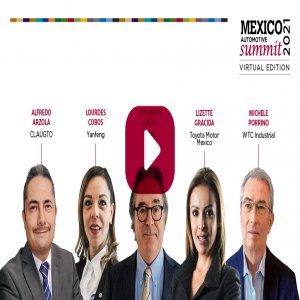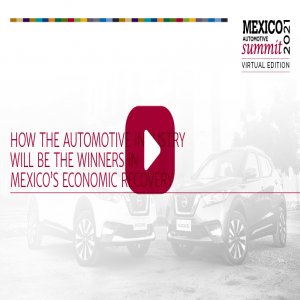
Rules of Origin Change Approach to Regional Content
You can watch the video of this panel here.
While they will certainly bring challenges, USMCA’s new rules of origin are also bringing opportunities to Mexico as OEMs and Tier 1s are forced to increase the percentage of regional content, which could translate into the development of more local suppliers. However, developing local suppliers can be a taxing process due to the numerous requirements and certifications necessary to produce for the automotive industry. In the panel “Suppliers Development in a New USMCA Era,” speakers representing clusters, financers and different levels of the supply chain addressed both the opportunities brought by the USMCA and challenges that the generation of local suppliers will represent.
USMCA means a new chapter for Mexico’s automotive supply chain, agreed speakers at Mexico Automotive Summit on Wednesday, Mar. 24. “NAFTA did not provide strong incentives to local manufacturers. It promoted imports and led companies to bring suppliers from their native countries, such as Germany or China,” said Manuel Montoya, President of the National Automotive Clusters Network and CLAUT. For that reason, OEMs did not have the need to look for local suppliers. The new rules of origin for automotive goods demand an increase in regional content for core, principal and complementary parts for light and heavy vehicles.
In the case of light vehicles, RVC has to increase to 75 percent in a three-year period, while for heavy vehicles it will increase to 70 percent in a seven-year period. However, the changes go deeper. “USMCA changed the rules and made them stricter. It is not just a 62.5 percent to 75 percent change; Tier 1s can no longer just import parts and assembly them locally. Now, the parts have to be manufactured in the region,” said Montoya. This is forcing Tier 1s to look for local suppliers.
“Rules of origin are changing how we look for regional content,” said Ricardo Coto, Purchasing Director of Metalsa, a Tier 1 company. But introducing a new supplier to the value chain is not a light decision. "The pandemic, the economic environment, the trade war and USMCA have made us reflect on how we look for businesses," he added. The complex environment companies are facing is leading them to carefully evaluate not just the quality and capability of a supplier, but also its long-term financial stability. “It is important to identify which companies are vulnerable to crises and look for schemes to strengthen the supply chain through financing and partnerships," said Coto.
Small suppliers might need financial support through partnerships or loans to weather crises, agreed speakers. But getting a loan might not be entirely straightforward as financers are playing close attention to a company’s practices beyond their manufacturing operations. “Social responsibility is becoming increasingly important and companies that do not comply with these norms will have trouble getting financing from any bank,” said Diego Spannaus, Head of Trade and Receivables Finance, Mexico and Latin America at HSBC.
Suppliers also have to innovate to remain competitive, especially in an industry where quality and short delivery times are key. “The automotive industry is extremely challenging not just in terms of quality and delivery times, but also prices,” said Felipe Villareal, CEO of Alian Plastics, a Tier 2 company. For that reason, suppliers at all Tiers have to invest in efficiency to truly stand out. "Better day-to-day operational risk management, driving innovation and building brand awareness are key to staying ahead in an industry like automotive,” said Villareal.
However, the main challenge suppliers across the value chain might face lays in convincing the client that cheaper is not always better. “It is necessary to shift perception from reducing price to increasing value,” said Coto. As manufacturers race to find the lowest price, key quality principles might fall on the wayside, which will put low-quality producers in a poor position to compete.
"Competitive pricing without quality and short delivery times is no longer useful in the automotive industry,” added Coto. In that sense, innovation can be essential to keep quality up and costs down. “The first step to make a sustainable company is to contain costs through building brand value and implementing technologies such as Industry 4.0, which allows us to have decision-making information readily available,” said Villareal. Spannaus agreed and highlighted the importance of looking for added value at all points of the supply chain. “Cost is a consideration for all companies but only looking for the cheapest price is not the best option when looking for a supplier or a financer,” said Spannaus.

















